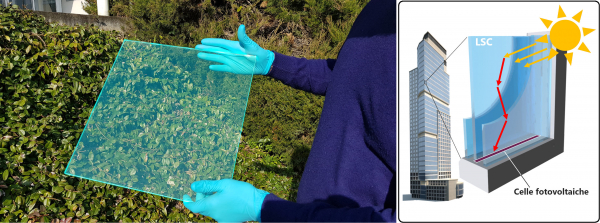The results of this study, published on Joule - Cell Press, demonstrate that devices based on such simple technology can reach high efficiencies in the conversion of solar energy in electrical power, comparable with those obtained by state-of-the-art materials in this kind of device, with the advantage of environmentally friendly synthesis processes.
“The functioning is based on an intrinsic property of several classes of organic molecules: the adrorption of solar light across a wide range of wavelength, followed by emission at a well separated and well defined wavelength”, Giuseppe Mattioli (Cnr-Ism) told. “Molecules having this features which are also thermally-stable and light-resistant are dispersed inside Plexiglas sheets for windows. The sheets act as efficient and cost-effective wavelet to trap the radiation and concentrate it at the sheet edges”. The sheets are mounted in a common window frame where thin and invisible photovoltaics cells convert the concentrated light to electricity.
Luca Beverina (University of Milano – Bicocca) added: “The main advantage in process innovation lyes in the usage of molecules which require a simple and fast synthesis, devoid of processing solvents and, therefore, intrinsically greener. The synthesis is performed using a mechano-chemical technique in which reactants are dry-mixed in a ball miller, ensuring high reaction rates at short contact time even without using solvents. This process allows to reach an unprecedented weight ratio between waste and final product (E factor, the most popular sustainability index in materials chemistry), 50 times lower than that related to molecules having similar efficiencies”.
The benefits don’t stop here: “As opposed to conventional, silicon-based photovoltaics devices -which are opaque and dark, or semi-transparent at most- our material permits to make transparent sheets, with obvious aesthetic and functional advantages”, Mattioli continued. “Moreover, this kind of device has wider positioning flexibility with respect to the sun than conventional solar panels, representing their ideal complement for diffuse generation of renewable electricity.”
Get in touch: Giuseppe Mattioli


 English (UK)
English (UK)  Italiano (Italia)
Italiano (Italia)